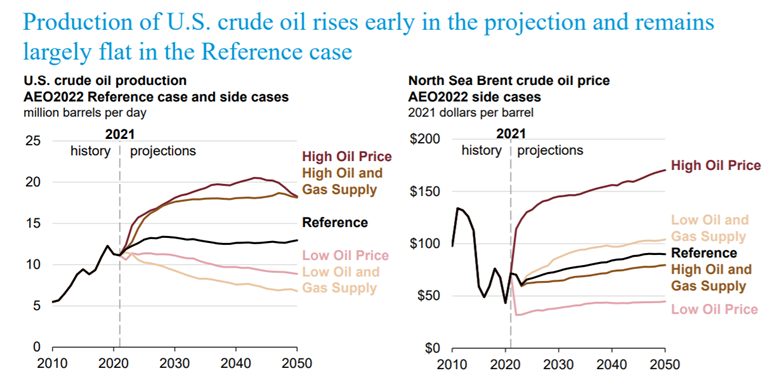Petroleum and Natural Gas Remain #1 Through 2050
Petroleum and natural gas will remain the most-consumed sources of energy in the United States through 2050, according to the U.S. Energy Information Administration’s 2022 Annual Energy Outlook. The long-term analysis doesn’t see liquid fuels or natural gas losing the top spot of consumed energy in the United States, holding its position in the national energy portfolio under a number of scenarios, including projections with growing wind and solar capacity.
Production and Exports: Oil and Natural Gas
The United States ended 2021 as the world’s largest LNG exporter and the EIA projects that the record levels of exports will continue to grow through 2020 before stabilizing at an all-time high around 2033. The nation is well prepared to meet the growing international demand for reduced emissions energy through these record levels of LNG exports to parties abroad, and through increased natural gas pipeline exports to Canada and Mexico.

The growth in natural gas exports works in tandem with an increasing production trend and demand for U.S LNG abroad. More than one third of natural gas production growth through 2050 is projected to be exported. According to EIA’s Assistant Administrator for Energy Analysis, Angelina LaRose:
“We project natural gas exports to continue to grow through 2025 as U.S. LNG capacity expands…Beyond 2025, we project that natural gas production will ramp up to meet this growing export demand, the majority of which will be LNG. We project global demand for U.S. natural gas to pass current and announced LNG export capacity, making additional LNG capacity economical. These LNG export capacity expansions coupled with strong demand for natural gas abroad increase LNG exports to close to six trillion cubic feet or roughly 16 billion cubic feet per day by 2033 in the reference case, supporting natural gas production growth in the medium and long term.” (emphasis added)
Crude oil will retain its relatively high production levels through 2050 and exports remain near their projected peak, stabilizing in gross terms and as a percentage of total domestic crude oil production.

Continued Decrease in Power Generation Emissions
Natural gas will continue to play a role in the electric power section clear through 2050, enabling the integration of renewables to a record high at 44 percent of the national energy portfolio. The EIA projects natural gas electricity generation to remain relatively flat through 2035, with increased generation from 2035 to 2050 due to electricity demand growth, relatively flat natural gas prices, more efficient natural gas plants, and a higher percentage of non-dispatchable renewable generators on the grid.
Natural gas will provide the immediate energy needs that renewables cannot guarantee, providing low carbon energy and stabilizing energy markets. This trend of relatively high natural gas use continues through 2050 even in a scenario of low-cost renewables.

The trend of coal-to-gas switching for power generators will continue in the reference case thanks to improved efficiencies and low-cost natural gas, meaning further reduced power sector emissions. Emissions are projected to decrease from 2022 to 2027, continuing the 33 percent decrease in power sector CO2 emissions between 2005 to 2019 that was achieved in part because of a 108 percent increase in natural gas-fired electric generation.
Conclusion
Traditional energy resources will play a substantial role in an all-of-the-above energy mix. Their role in America’s infrastructure, economy, and homes will remain a staple, even as the share of renewable power generation doubles between now and 2050. Global energy production is projected to increase 50 percent with the United States playing a key role in meeting global demand for low carbon energy through continued exports of petroleum and natural gas products.

No Comments